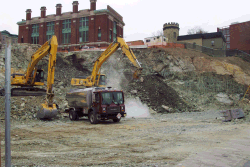 Excavation site in April 2002, where 35,000 tons of serpentine rock containing asbestos was blasted and carted away by Stevens.
Excavation site in April 2002, where 35,000 tons of serpentine rock containing asbestos was blasted and carted away by Stevens.
(July 2004)
On June 30, Judge Camille Kenny of New Jersey Superior Court heard oral arguments regarding a series of alleged defamatory statements in the case of Stevens Institute v. Hine. After 18 months of contentious litigation, the Judge considered for the first time the defamation charges. Attorney Charles Fisher, representing Stevens, tried to convince the Judge that this case should go to trial. The defendants filed a motion for summary judgment, the subject of the oral arguments, contending that, as a matter of law, none of the statements are defamatory.
It began in early April, 2002, when Ron Hine and Aaron Lewit of the Fund for a Better Waterfront learned that the serpentine rock being blasted and excavated by Stevens at its campus contained asbestos. They filed a complaint with the Hoboken Board of Health. Hine then posted articles on the FBW website about the operation sending clouds of asbestos dust into the air and the lack of precautions taken, such wetting the site to control the dust during the four weeks since the operation began. To further bring the matter to the public’s attention, Hine and Lewit also wrote letters to the Jersey Journal and Hoboken Reporter. Hine also wrote to the Mayor of Hoboken asking for the City to stop the work until a plan could be put into place assuring everyone’s safety.
In January 2003, Stevens Institute filed suit, accusing Hine, Lewit and the Fund for a Better Waterfront of defaming the university. Stevens cited 10 statements from the website, letters to the editor and the letter to the Mayor. At Wednesday’s oral arguments, the Judge focused her attention on each of these statements, taking them one by one.
In court, Fisher on behalf of the plaintiff Stevens Institute, argued that this case should go to trial so the university can prove scientifically that no hazard was caused by the excavation of 30,000 tons of asbestos-rock at the campus in 2002. In their briefs, both sides presented certifications from two experts. The Judge, however, did not appear convinced that a battle of the experts would be necessary to resolve this dispute.
A number of times, the Judge cited the New Jersey Supreme Court case of DeAngelis v. Hill decided just a month earlier, in May 2004. In this case, the state’s highest court reversed the lower courts’ ruling for failure to dismiss a defamation case on summary judgment. The Courts have found that a plaintiff has the burden of proof and must show that a defendant acted with actual malice. To prove actual malice, plaintiffs must establish that statements were made with reckless disregard for the truth.
After two hours of argument, Judge Kenny had gone through 5 of the 10 statements and eliminated a number of them for not being capable of defamatory meaning and left several for further review. She has not yet heard arguments on the issue of whether or not Stevens Institute was damaged by any of these statements. When the case continues on Thursday, July 8, the Judge is expected to wrap up the arguments on this summary judgment motion. At that point, she is likely to determine whether the case will go to trial or be dismissed.
In their briefs, defendants show how Stevens deliberately distorted the record in order to fabricate a case against the leaders of an organization that spoke out of concern for the public’s health and safety. The briefs also detail how the defendants spoke with numerous experts in order to understand the threat posed by putting asbestos into the air before making their statements.
One geologist advised FBW executive director Ron Hine that when it comes to asbestos, a know carcinogen, there is no lower threshold. Another geologist, Michael Mooney, who advised Hine and Lewit, stated in his deposition, “Do I feel there is a health hazard? Most definitely. . . The particles [of asbestos] in these rocks tend to be less than a 125 microns in size, which are small enough to be airborne particles, which makes it a very hazardous type of rock.”
In claiming “no hazard existed,” Stevens cited Assistant Director of the Hudson Regional Health Commission, Gary Garetano as its star witness. Yet in his deposition, Garetano called the operation on Stevens’ campus, “a nightmare.” When Stevens’ attorney asked Garetano if he felt that construction activities constituted a health hazard, he replied, “I consulted with the Health Department on it and I certainly expressed my concerns of the potential for inhalation of asbestos, that the potential for inhalation of asbestos existed and that that’s not a good thing.”
In its brief, Stevens made the claim that no hazard existed at the construction site because most of the daily air monitoring reports show levels of asbestos in the air samples that are below the 70 structures per square millimeter level. FBW presented an expert who refuted that claim. Industrial hygienist Edward Olmsted stated in his certification, “Air sampling alone [is] not sufficient to accurately characterize the degree of risk. Air sampling is a snap shot in time and is prone to significant error especially when samples are collected for only 6 hours each day.”
Stevens claims are further refuted by the EPA Inspector General who questioned the monitoring at the World Trade Center site. In their brief, FBW’s attorneys cite the Inspector General’s report that concluded the EPA did not have sufficient data to support its September 18, 2001 statement that the air near ground zero was “safe” to breathe, and that the standards it used to support this conclusion (the 70 structures per square millimeter) were not health-based benchmarks.
FBW News Archive

